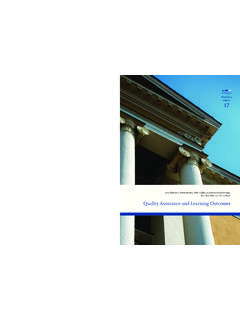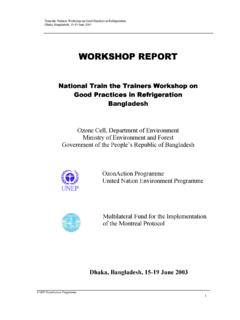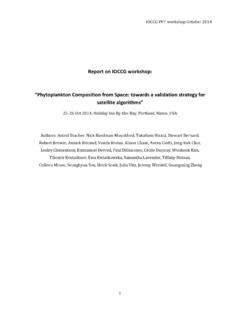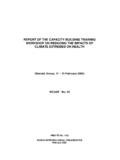Transcription of Microplastics Expert Workshop Report - epa.gov
1 1 Microplastics Expert Workshop Report Trash Free Waters Dialogue Meeting Convened June 28-29, 2017 EPA Office of Wetlands, Oceans and Watersheds Primary Author: Margaret Murphy, AAAS S&TP Fellow Report Date: December 4, 2017 2 EPA Microplastics Expert Workshop Report Executive Summary Recent global efforts to better understand Microplastics distribution and occurrence have detailed both the ubiquity of Microplastics and the uncertainties surrounding their potential impacts. In light of this scientific uncertainty, the US Environmental Protection Agency (EPA) convened a Microplastics Expert Workshop in June 2017 to identify and prioritize the scientific information needed to understand the risks posed by Microplastics (broadly defined as plastic particles <5 mm in size in any one dimension ( Arthur et al.))
2 2009)) to human and ecological health in the United States. The Workshop gave priority to gaining greater understanding of these risks, while recognizing that there are many research gaps needing to be addressed and scientific uncertainties existing around Microplastics risk management ( , waste management/recycling/ circular economy principles, green chemistry approaches to developing alternatives to current-use plastics). The Workshop participants adopted a risk assessment-based approach and addressed four major topics: 1) Microplastics methods, including deficits and needs; 2) Microplastics sources, transport and fate; and 3) the ecological and 4) human health risks of Microplastics exposure. A framework document was developed prior to the Workshop to guide discussion.
3 During the Workshop , the participants recommended adopting a conceptual model approach to illustrate the fate of Microplastics from source to receptor. This approach is helpful in describing the various scientific uncertainties associated with answering the overarching questions of the ecological and human health risks of Microplastics , the degree to which information is available for each, and the interconnections among these uncertainties. Draft conceptual models were developed during the Workshop , and these draft models were the basis for more detailed models developed through discussions and comments from the participants after the Workshop . The resulting detailed models are introduced and explained in the main body of this Report .
4 The participants identified the following priority scientific information needs within each of the four research topics discussed during the Workshop : Methods needs: Establish reproducible, representative, accurate, precise methods formicroplastics analysis that include appropriate quality assurance/quality control (QA/QC)for: Microplastics sample collection; Microplastics extraction from surface and drinkingwater, dust, sediment and tissue samples; Microplastics characterization (size, shape andchemical composition [polymer, as well as additive chemicals]); and microplasticsquantification, particularly for particles in the micron scale ( 1 m and 1 mm in size) forwhich information is limited and which are relevant to human and ecological exposure risks.
5 Microplastics sources, transport and fate needs: Conduct research on the sources,transport, fate, and distribution of Microplastics in the environment to be used for exposurecharacterization in risk assessment of human and ecological health impacts, particularly tounderstand and characterize: (a) how consumer product use and wear, agricultural practicesand waste management processes (including sludge land application and landfill leachate) inthe US contribute to Microplastics in the environment, and (b) how particle characteristicssuch as chemical composition ( , polymer type) affect Microplastics behavior (transport,degradation, and distribution);3 Ecological assessment needs: Create standardized toxicity tests for Microplastics in testorganisms and ecologically representative organisms and systems (including field studies) tounderstand the ecological impacts of Microplastics , considering whether standardlaboratory tests and endpoints can be applied to Microplastics toxicity assessments,bioavailability of Microplastics and their additive chemicals (especially particle translocationand chemical bioaccumulation), and how dose-response relationships can be developed formicroplastics to better understand the full range of their potential impacts.
6 And Human health assessment needs: Create methods and conduct research to characterizehuman exposure to and impacts from Microplastics in drinking water (including sourcewater), seafood, freshwater fish and indoor/outdoor dust, in order to assess potentialhuman health the needs identified above, the Workshop participants echoed the conclusion of many Microplastics review papers and reports that the development of reliable, reproducible and high-quality methods for Microplastics quantification and characterization is fundamental and of paramount importance for understanding Microplastics risks. These priority scientific information needs are reflected in the discussion and conceptual models presented below. Graphic representations of the models are provided on pages 11, 14, 17, and 20 of this Report .
7 4 Workshop Participants and Observers Participants Name Agency/Affiliation Invited Experts Robert Hale Virginia Institute of Marine Science Paul Helm Ontario Ministry of the Environment Jenna Jambeck University of Georgia Kara Lavender Law Sea Education Association Chelsea Rochman University of Toronto Environmental Protection Agency Christine Bergeron Office of Water, Office of Science & Technology Robert Burgess Office of Research & Development, Atlantic Ecology Division Bob Cantilli Office of Research & Development, Office of Science Policy Anna-Marie Cook Office of Research & Development, Region 9 Superfund and Technology Liaison Stanley Durkee Office of Research & Development, Office of Science Policy Kay Ho Office of Research & Development, Atlantic Ecology Division Greg Miller Office of Water, Office of Science & Technology Other Federal Agencies Kathy Conn US Geological Survey, Washington Water Science Center Carlie Herring National Oceanic & Atmospheric Administration, Marine Debris Program Emanuel Hignutt Food & Drug Administration, Center for Food Safety & Applied Nutrition Amy Uhrin National Oceanic & Atmospheric Administration, Marine Debris Program Other Margaret Murphy AAAS Science & Technology Policy Fellow, Program Participant in the EPA Office of Water Observers Name Agency/Affiliation Environmental Protection Agency Sandra Connors Office of Water, Office of Wetlands.
8 Oceans & Watersheds Kathryn Gallagher Office of Water, Office of Science & Technology Laura Johnson Office of Water, Office of Wetlands, Oceans & Watersheds Noemi Mercado Office of Water, Office of Wetlands, Oceans & Watersheds Kate O'Mara Office of Research & Development, Office of Science Policy Brian Rappoli Office of Water, Office of Wetlands, Oceans & Watersheds Grace Robiou Office of Water, Office of Wetlands, Oceans & Watersheds Surabhi Shah Office of Water, Office of Wetlands, Oceans & Watersheds Bernice Smith Office of Water, Office of Wetlands, Oceans & Watersheds Other Juliette Chausson ORISE Research Participant at the Office of Water, Office of Wetlands, Oceans & Watersheds, EPA Claudia Gelfond ORISE Research Participant at the Office of Water, Office of Science & Technology, EPA Alix Grabowski World Wildlife Fund Mike Levy American Chemistry Council Emma Maschal ORISE Research Participant at the Office of Water, Office of Wetlands, Oceans & Watersheds, EPA 5 Introduction Plastics pollution has raised concern worldwide, with a recent study estimating that 8 million metric tons of plastics was released into the world s oceans in 2010 (Jambeck et al.)
9 2015). Freshwater and terrestrial systems are also affected by plastics pollution, and research over the past few decades has shown that plastic items such as derelict fishing gear and plastic grocery bags can have detrimental effects on wildlife via entanglement and ingestion (reviewed by Browne et al. 2015; Provencher et al. 2017). More recently, studies conducted around the world have shown that Microplastics , plastic particles <5 mm in size in any one dimension (Arthur et al. 2009), are widespread in marine and freshwaters, and may also have negative ecological impacts (GESAMP 2015; 2016). Since its inception in 2013, the EPA s Trash Free Waters (TFW) program has pursued a multi-pronged approach to reducing and preventing trash in US waters, including plastics.
10 One part of this approach assesses the current state-of -the-science of understanding the ecological and human health impacts of trash in the environment. As part of this approach, TFW convened the Expert Discussion Forum on Possible Human Health Risks from Microplastics in the Marine Environment in April 2014 (US EPA 2015). This discussion forum brought together experts in plastics and Microplastics to share their perspectives on Microplastics pollution. The discussion at the forum focused on Microplastics as vectors for persistent, bioaccumulative and toxic substances (PBT), and the participants determined that priority should be given to understanding the relative contribution of PBTs sorbed to or present in Microplastics in the context of other PBT sources to seafood to better assess human health risks.


















